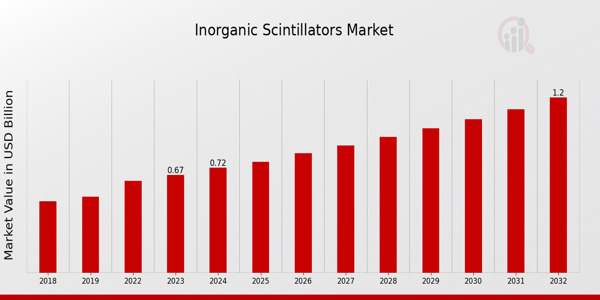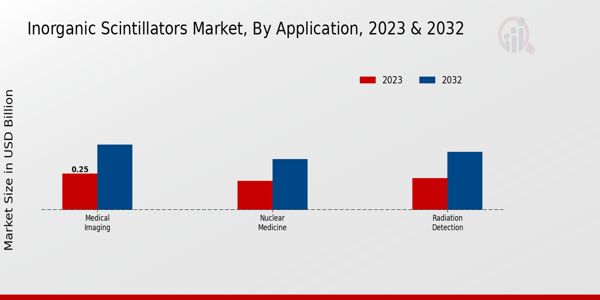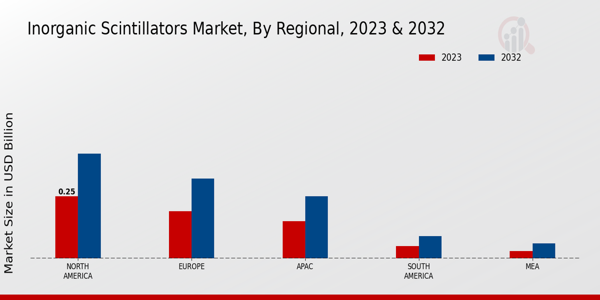Global Inorganic Scintillators Market Overview
The Inorganic Scintillators Market Size was estimated at 0.76 (USD Billion) in 2024. The Inorganic Scintillators Industry is expected to grow from 0.81 (USD Billion) in 2025 to 1.45 (USD Billion) by 2034. The Inorganic Scintillators Market CAGR (growth rate) is expected to be around 6.6% during the forecast period (2025 - 2034).
Key Inorganic Scintillators Market Trends Highlighted
The Inorganic Scintillators Market is experiencing significant growth driven by the increasing demand for advanced radiation detection technologies. One of the primary market drivers is the rising need for safety and security in various sectors, including healthcare, nuclear energy, and defense. As regulations surrounding radiation safety tighten, there is a growing requirement for effective scintillation detectors that can provide accurate and real-time measurements. Furthermore, advancements in technology are leading to enhanced performance of inorganic scintillators, making them more appealing to end-users. Opportunities to be explored include the expansion of applications in emerging fields.For instance, the integration of these materials in cancer therapy and diagnostics opens up new avenues for market players. Additionally, emerging markets in Asia-Pacific and Latin America present significant growth potential due to increased investments in healthcare and nuclear infrastructure. Companies that can innovate and tailor their products to meet regional needs will likely capture these opportunities and expand their market presence. Trends in recent times show a shift toward developing materials that exhibit improved efficiency and better light output. Research and development in the field are focusing on creating new composite scintillators that combine different materials for enhanced performance.Moreover, there is a noticeable trend of collaboration between manufacturers and research institutions to accelerate innovation. The rise of digital electronics and the need for compact and lightweight detectors are also influencing the design and development of scintillator materials, further propelling the market forward. With sustainability becoming a crucial consideration, manufacturers are also exploring eco-friendly alternatives, aligning their production processes with global environmental goals. The combination of these factors illustrates a dynamic and evolving landscape in the Inorganic Scintillators Market.

Source: Primary Research, Secondary Research, MRFR Database and Analyst Review
Inorganic Scintillators Market Drivers
Growing Demand for Radiation Detection and Monitoring
The increasing emphasis on safety and health in various sectors has led to a surge in the demand for radiation detection and monitoring solutions. Industries such as healthcare, nuclear power, and environmental monitoring require precise and reliable instruments for measuring radiation levels. The Inorganic Scintillators Market Industry is experiencing growth as these materials are critical components in detectors used for medical imaging, radiation therapy, and security screening applications.As safety regulations tighten and the need for monitoring increases, the demand for inorganic scintillators is expected to rise. The ability of these materials to convert ionizing radiation into visible light with high efficiency makes them indispensable in various applications. In healthcare, for instance, advancements in imaging technologies, such as positron emission tomography (PET) and single-photon emission computed tomography (SPECT), are driving the need for high-performance scintillation materials.Coupled with the growing awareness of radiation safety and the need for routine monitoring in workplaces and public spaces, the Inorganic Scintillators Market is poised for significant expansion, ultimately leading to innovations in scintillator materials and designs to better serve various industries.
Technological Advancements in Scintillator Materials
Innovations in material science and engineering have resulted in significant advancements in scintillator technologies, enhancing the performance of inorganic scintillators. New materials and fabrication techniques increase the light yield, energy resolution, and radiation resistance of scintillators, expanding their potential applications across numerous fields. In the Inorganic Scintillators Market Industry, these improvements are crucial for meeting the growing demands for high-performance radiation detection systems.The introduction of novel compounds and composites allows for applications that were not feasible with traditional scintillators, thereby broadening the market scope. As researchers and manufacturers continue to focus on developing more efficient and versatile scintillator materials, the market is anticipated to grow steadily.
Expansion of Research and Development Activities
The surge in research and development initiatives aimed at exploring various applications of inorganic scintillators is a significant driver of the market. This focus on R is fostering the discovery of new applications, enhancing existing technologies and optimizing manufacturing processes. As new potential uses for scintillator materials emerge in sectors like nuclear medicine, astrophysics, and industrial inspection, the importance of innovative research cannot be overstated.
Such as an increase in funding and investment in scientific research, along with the development made in the scintillation detectors, have had a positive impact on the Inorganic Scintillators Market Industry. Advancements in the R constantly seek progress and are persistent for future growth potential in the industry.
Inorganic Scintillators Market Segment Insights:
Inorganic Scintillators Market Application Insights
The Inorganic Scintillators Market, particularly in the Application segment, has exhibited significant growth and potential, with a market value reaching 0.67 USD Billion in 2023 and expected to rise to 1.2 USD Billion by 2032. Within this segment, the major applications are categorized into Medical Imaging, Nuclear Medicine, and Radiation Detection, each contributing to the overall performance of the market. The Medical Imaging segment is anticipated to hold a majority share of the market, valued at 0.25 USD Billion in 2023 and projected to expand to 0.45 USD Billion by 2032. This growth is primarily driven by the increasing demand for advanced diagnostic imaging technologies, where inorganic scintillators play a crucial role in enhancing image quality and accuracy, thereby improving patient outcomes.
In addition, the Nuclear Medicine segment, valued at 0.2 USD Billion in 2023 and expected to grow to 0.35 USD Billion by 2032, is crucial for the diagnosis and treatment of various diseases, including cancer. The integration of inorganic scintillators in this field significantly aids in the detection of gamma radiation, making them indispensable in advancing therapeutic procedures and contributing to patient safety.
Meanwhile, the Radiation Detection application, valued at 0.22 USD Billion in 2023 and projected to reach 0.4 USD Billion by 2032, is increasingly vital in both industrial and healthcare settings for ensuring safety and regulatory compliance. As the demand for improved radiation safety measures rises, the importance of inorganic scintillators in this area becomes even more pronounced.
The combination of these applications paints a clear picture of the substantial potential within the Inorganic Scintillators Market, driven by technological advancements and heightened awareness surrounding health and safety. The overall market data indicates a positive trend in these segments, showcasing growth opportunities that align with ongoing developments in medical technology, safety protocols, and treatment modalities across various healthcare and industrial applications.

Source: Primary Research, Secondary Research, MRFR Database and Analyst Review
Inorganic Scintillators Market Material Type Insights
Sodium Iodide is renowned for its efficiency in gamma-ray spectroscopy, widely utilized in medical imaging and radiation monitoring applications. Cesium Iodide stands out due to its superior light yield and fast response time, making it a preferred choice in high-energy physics and nuclear medicine, thereby dominating a substantial share of the market.Bismuth Germinate, while less common, offers unique properties that cater to specific applications in scientific research, thereby holding a significant position within this segment. Overall, the strategic developments and growing demand for precise detection and imaging solutions in various sectors are driving the Inorganic Scintillators Market growth, reflected in its projected increase to 1.2 USD Billion by 2032. Market trends favoring advanced detection technologies alongside increasing investment in the healthcare sector further enhance the relevance of the Material Type segment in the overall Inorganic Scintillators Market industry.As a result, the landscape offers considerable opportunities, complemented by challenges related to raw material sourcing and competition from organic scintillators.
Inorganic Scintillators Market End Use Insights
Within the End Use segment, significant applications are noted, especially in the Healthcare, Defense and Industrial sectors. The healthcare aspect is crucial, primarily in medical imaging and diagnostic applications, facilitating advanced patient care through enhanced imaging capabilities. The Defense sector prominently utilizes inorganic scintillators for radiation detection and surveillance, ensuring national security and safety.Meanwhile, Industrial applications are increasingly recognizing their value in monitoring environmental radiation levels and in various manufacturing processes. The overall growth trend reflects an increasing demand in these areas, fueled by technological advancements, a growing focus on health and safety standards and the rising need for effective radiation monitoring systems. With a strong market growth projected to accelerate through 2032, the Inorganic Scintillators Market segmentation highlights how diverse applications in these vital sectors are driving robust market dynamics.The expanding use of inorganic scintillators showcases their significance in various industries and underlines opportunities for innovation and expansion in market reach.
Inorganic Scintillators Market Form Factor Insights
This segmentation is critical as it caters to various applications, with Crystals often commanding a significant share due to their superior light output and energy resolution, making them indispensable in medical imaging and radiation detection. Powders also play a vital role, particularly in research and development scenarios where flexibility and cost-effectiveness are essential.Pellets are gaining traction for their ease of handling and integration in various detection systems, reflecting the evolving needs of the industry. As the Inorganic Scintillators Market continues to grow, driven by increasing demand for radiation detection and imaging technologies, these form factors are expected to reshape industry dynamics. The ongoing advancements in materials technology further present opportunities for innovation, enhancing performance and application range. Market trends indicate a consistent push towards optimizing these form factors, reflecting the broader need for effective and efficient solutions in the field of radiation measurement and detection.
Inorganic Scintillators Market Regional Insights
North America holds the majority market share with a valuation of 0.25 USD Billion in 2023 and is projected to reach 0.42 USD Billion in 2032, reflecting strong demand driven by advancements in medical imaging technologies. Europe follows closely, valued at 0.19 USD Billion in 2023 and expected to reach 0.32 USD Billion by 2032, supported by increasing applications in radiation detection and environmental monitoring.The Asia-Pacific (APAC) region is growing steadily, with its market valued at 0.15 USD Billion in 2023, moving to 0.25 USD Billion by 2032, driven by industrial applications and expanding healthcare infrastructure. South America and the Middle East Africa (MEA) represent smaller segments, valued at 0.05 USD Billion and 0.03 USD Billion in 2023, respectively, yet both regions are poised for gradual growth. The development of scintillator materials and the rising demand for high-performance detection systems in multiple applications present opportunities for growth within these regions, thereby shaping the Inorganic Scintillators Market revenue and segmentation landscape.

Source: Primary Research, Secondary Research, MRFR Database and Analyst Review
Inorganic Scintillators Market Key Players and Competitive Insights:
The Inorganic Scintillators Market is characterized by a diverse range of players who vie for supremacy in technology, product innovation, and customer engagement. This market is primarily driven by the increasing demand for high-performance scintillator materials in various sectors, including healthcare, nuclear energy, and industrial applications. As competition intensifies, companies are focusing on research and development to enhance the efficiency, durability, and cost-effectiveness of their products. Additionally, strategic partnerships, mergers, and acquisitions are becoming common strategies to expand market reach and leverage complementary capabilities. Market dynamics are influenced by regulatory frameworks, technological advancements, and shifts in consumer preferences, all contributing to a compelling landscape that shapes the competitive strategies of key players.SaintGobain has established a substantial presence in the Inorganic Scintillators Market by leveraging its expertise in material science and innovation. The company is renowned for its advanced scintillator materials that are integral for a variety of applications, including medical imaging and radiation detection. SaintGobain distinguishes itself through its commitment to quality and performance, offering products that meet stringent industry standards. Its strong focus on research and development allows it to stay ahead in a competitive landscape, ensuring that its products are not only effective but also meet the evolving needs of its customers. Furthermore, the company’s extensive distribution network and customer service capabilities bolster its market position, enabling it to respond rapidly to market demand and support its diverse client base effectively.Siemens has carved a significant niche in the Inorganic Scintillators Market, positioning itself as a leader in technological advancement and system integration. The company’s expertise lies in the development of high-quality scintillator materials that are essential in medical diagnostics, including advanced imaging systems and radiation therapy. Siemens’ strong emphasis on innovation drives its continuous improvement in product performance and reliability, making its scintillator solutions a preferred choice among healthcare providers. Moreover, Siemens benefits from its established global footprint and collaboration with various sectors, allowing it to respond to market needs dynamically. The company's ability to integrate its scintillator products with sophisticated detection systems enhances their application range, reinforcing its competitive advantage in the marketplace.
Key Companies in the Inorganic Scintillators Market Include:
- SaintGobain
- Siemens
- Infinia Corporation
- Hamamatsu Photonics
- Scintillation Counters
- Teledyne Judson Technologies
- Eljen Technology
- Luzchem Research
- RMD Instruments
- Kromek Group
- Bicron
- Cleveland Crystals
- Nuclear Instrumentation Services
- SaintGobain Crystals
Inorganic Scintillators Market Industry Developments
In recent developments within the Inorganic Scintillators Market, companies such as Saint-Gobain, Siemens, and Kromek Group have reported advancements in technology aimed at enhancing scintillator performance for various applications, including medical imaging and security. Hamamatsu Photonics has introduced new scintillation materials that improve detection sensitivity, contributing to the growing demand in healthcare diagnostics. Furthermore, there has been notable interest in market growth, driven by increasing investments in nuclear safety and radiation detection technologies by organizations reliant on these materials. Recent reports highlight a significant uptick in the valuation of several key players, including Eljen Technology and Teledyne Judson Technologies, which has effectively strengthened their market presence. There are also speculative discussions regarding potential mergers and acquisitions in this sector, particularly involving companies like RMD Instruments and Nuclear Instrumentation Services, as they seek to consolidate their positions amidst competitive pressures. Overall, these developments underscore a dynamic and evolving landscape in the Inorganic Scintillators Market, leading to enhanced opportunities and collaborations among industry leaders.
Inorganic Scintillators Market Segmentation Insights
- Inorganic Scintillators Market Application Outlook
- Medical Imaging
- Nuclear Medicine
- Radiation Detection
- Inorganic Scintillators Market Material Type Outlook
- Sodium Iodide
- Cesium Iodide
- Bismuth Germinate
- Inorganic Scintillators Market End Use Outlook
- Healthcare
- Defense
- Industrial
- Inorganic Scintillators Market Form Factor Outlook
- Inorganic Scintillators Market Regional Outlook
- North America
- Europe
- South America
- Asia Pacific
- Middle East and Africa
| Report Attribute/Metric |
Details |
| Market Size 2024 |
0.76 (USD Billion) |
| Market Size 2025 |
0.81 (USD Billion) |
| Market Size 2034 |
1.45 (USD Billion) |
| Compound Annual Growth Rate (CAGR) |
6.6% (2025 - 2034) |
| Report Coverage |
Revenue Forecast, Competitive Landscape, Growth Factors, and Trends |
| Base Year |
2024 |
| Market Forecast Period |
2025 - 2034 |
| Historical Data |
2020 - 2024 |
| Market Forecast Units |
USD Billion |
| Key Companies Profiled |
SaintGobain, Siemens, Infinia Corporation, Hamamatsu Photonics, Scintillation Counters, Teledyne Judson Technologies, Eljen Technology, Luzchem Research, RMD Instruments, Kromek Group, Bicron, Cleveland Crystals, Nuclear Instrumentation Services, SaintGobain Crystals |
| Segments Covered |
Application, Material Type, End Use, Form Factor, Regional |
| Key Market Opportunities |
1. Growing demand in medical imaging, 2. Advancements in detection technology, 3. Increasing use in radiation monitoring, 4. Expanding applications in homeland security, 5. Rising investments in nuclear research |
| Key Market Dynamics |
1. increasing demand for radiation detection, 2. technological advancements in materials, 3. growing applications in healthcare, 4. stringent regulatory standards, 5. rising awareness of safety protocols |
| Countries Covered |
North America, Europe, APAC, South America, MEA |
Frequently Asked Questions (FAQ) :
The Inorganic Scintillators Market is expected to be valued at 1.45 USD Billion by 2034.
The expected CAGR for the Inorganic Scintillators Market from 2025 to 2034 is 6.6%.
North America is projected to dominate the Inorganic Scintillators Market with a value of 0.42 USD Billion by 2034.
The market size for Medical Imaging applications in the Inorganic Scintillators Market is expected to be 0.45 USD Billion by 2034.
Key players in the Inorganic Scintillators Market include SaintGobain, Siemens, and Hamamatsu Photonics.
The expected market value for Radiation Detection applications is projected to reach 0.4 USD Billion by 2034.
The Inorganic Scintillators Market is expected to be valued at around 0.67 USD Billion in 2024.
The market for Nuclear Medicine applications is expected to grow to 0.35 USD Billion by 2034.
The projected market size for the APAC region in 2034 is expected to be 0.25 USD Billion.
The market faces challenges related to technological advancements while also having opportunities to expand medical and radiation detection applications.

















